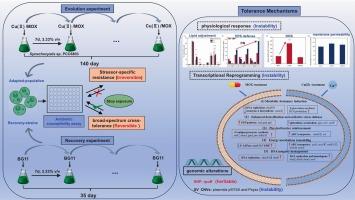慢性铜和莫西沙星胁迫下蓝藻的耐受性进化:表型可塑性和基因组固定
IF 4.5
2区 生物学
Q1 BIOTECHNOLOGY & APPLIED MICROBIOLOGY
Algal Research-Biomass Biofuels and Bioproducts
Pub Date : 2025-10-01
DOI:10.1016/j.algal.2025.104327
引用次数: 0
摘要
由环境污染物驱动的抗生素耐药性究竟是一种短暂的生态反应,还是一种永久的进化转变,仍然是全球卫生领域的一个关键知识缺口。在此,我们追踪了主要病原菌聚胞菌(Synechocystis sp. PCC 6803)在环境相关浓度铜[Cu(II): 250 μg/L]和氟喹诺酮类抗生素莫西沙星[MOX: 20 μg/L]慢性暴露(140 d)下的抗生素耐受性演变。进化的蓝藻种群获得了高水平的耐受性,而没有明显的适应成本。值得注意的是,这种耐受性具有双重特征:多药交叉耐受性是短暂的,在去除应激源后是完全可逆的,而对选择性药物[Cu(II)或MOX]本身的耐受性是稳定的和可遗传的。多组学分析揭示了这种差异的机制基础。瞬时耐受性是由表型可塑性的高度动态形式驱动的,表现为转录重编程和大规模基因组变异,这些变异赋予了暂时的适应性优势,但在没有选择压力的情况下迅速丧失。相比之下,rpoB基因的点突变巩固了持续抗性。我们的研究结果表明,环境中的污染物可能会推动蓝藻细菌的抗生素耐药性进化,并促进持续的应激耐受性。这突出了水生环境中初级生产者作为抗生素耐药性储存库和抗生素耐药性传播媒介的潜在风险,强调了在“同一个健康”框架下进行综合风险评估和源头控制战略的必要性。本文章由计算机程序翻译,如有差异,请以英文原文为准。

Tolerance evolution in cyanobacteria under chronic copper and moxifloxacin stress: Phenotypic plasticity and genomic fixation
Whether antibiotic resistance driven by environmental pollutant represents a transient ecological response or a permanent evolutionary shift remains a critical knowledge gap in global health. Here, we tracked the antibiotic tolerance evolution of the primary producer Synechocystis sp. PCC 6803 under chronic exposure (140 d) to environmentally relevant concentrations of copper [Cu(II): 250 μg/L] and the fluoroquinolone antibiotic moxifloxacin [MOX: 20 μg/L], respectively. The evolved cyanobacterial populations acquired high-level tolerance without obvious fitness costs. Notably, this tolerance exhibited dual characteristics: multidrug cross-tolerance was transient and fully reversible upon stressor removal, whereas tolerance to the selective agent itself [Cu(II) or MOX] was stable and heritable. Multi-omics analyses revealed the mechanistic basis for this divergence. Transient tolerance was driven by a highly dynamic form of phenotypic plasticity—manifested as transcriptional reprogramming and large-scale genomic variations that conferred a temporary fitness advantage but were rapidly lost without selective pressures. In contrast, the persistent resistance was cemented by the point mutation in rpoB gene. Our findings demonstrate that pollutants in the environment may drive the antibiotic resistance evolution in cyanobacteria and foster persistent stress tolerance. This highlights the potential risks of primary producers in the aquatic environment as an antibiotic resistance reservoir and vectors for antibiotic resistance dissemination, underscoring the necessity of integrated risk assessment and source control strategies under the “One Health” framework.
求助全文
通过发布文献求助,成功后即可免费获取论文全文。
去求助
来源期刊

Algal Research-Biomass Biofuels and Bioproducts
BIOTECHNOLOGY & APPLIED MICROBIOLOGY-
CiteScore
9.40
自引率
7.80%
发文量
332
期刊介绍:
Algal Research is an international phycology journal covering all areas of emerging technologies in algae biology, biomass production, cultivation, harvesting, extraction, bioproducts, biorefinery, engineering, and econometrics. Algae is defined to include cyanobacteria, microalgae, and protists and symbionts of interest in biotechnology. The journal publishes original research and reviews for the following scope: algal biology, including but not exclusive to: phylogeny, biodiversity, molecular traits, metabolic regulation, and genetic engineering, algal cultivation, e.g. phototrophic systems, heterotrophic systems, and mixotrophic systems, algal harvesting and extraction systems, biotechnology to convert algal biomass and components into biofuels and bioproducts, e.g., nutraceuticals, pharmaceuticals, animal feed, plastics, etc. algal products and their economic assessment
 求助内容:
求助内容: 应助结果提醒方式:
应助结果提醒方式:


